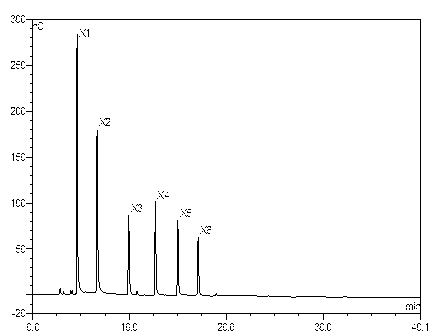Method for determining xylooligosaccharide through high-efficiency liquid-phase ion exchange chromatography
A technology of ion exchange chromatography and xylooligosaccharides, which is applied in the field of xylooligosaccharide determination, can solve the problem of inability to distinguish and quantitatively measure different xylosaccharide components, low separation of sugar components, and poor reproducibility of results and other issues to achieve the effect of improving the resolution and detection efficiency
- Summary
- Abstract
- Description
- Claims
- Application Information
AI Technical Summary
Problems solved by technology
Method used
Image
Examples
Embodiment 1
[0038] Example 1 High Performance Liquid Phase Ion Exchange Chromatography System and Chromatographic Conditions
[0039]High performance liquid phase ion exchange chromatography system: American Dionex ICS-3000 ion chromatography system, equipped with double pump (DP) built-in vacuum degassing module, electrochemical detector (ED) and automatic sampler (AS40), operating software of chromatography system Using Chromeleon 6.70 chromatographic workstation, chromatographic conditions: chromatographic column: CarboPacTM PA200 (3×250m) chromatographic column with guard column (3×50mm); column temperature: 30°C; injection volume: 10.0 μL;
[0040] Elution conditions: 500 mmol / L sodium acetate and 100 mmol / L sodium hydroxide were used as eluents for binary gradient elution, the flow rate was 0.3 mL / min, and the concentration gradient of sodium acetate solution elution within 0 to 40 min was 0~120mmol.
[0041] Signal detection: The detection mode of the electrochemical detector is g...
Embodiment 2
[0044] Embodiment 2 Determination of xylo-oligosaccharide standard working equation
[0045] The standard working equation for the determination of xylooligosaccharides: standard products of xylose, xylobiose, xylotriose, xylotetraose, xylopentaose and xylohexaose (produced by Megazyme, Ireland, purity >95%) were prepared to 0.5 ~10mg / L standard solution, using the above-mentioned high performance liquid phase ion exchange chromatography system and chromatographic conditions to determine the standard working equation of xylose to xylose hexose, the measurement results are as follows figure 1 and Figure 4 shown.
[0046] Chromatographic peak retention time RT (min): xylose 4.600, xylobiose 6.667, xylotriose 9.934, xylotetraose 12.684, xylopentaose 15.000, xylohexaose 17.100.
[0047] Standard working equation:
[0048] Xylose A=3.5218c 1 -0.0193, correlation coefficient R 2 =0.9989;
[0049] Xylobiose A=3.0798c 2 -0.1026, correlation coefficient R 2 =0.9998;
[0050] ...
Embodiment 3
[0059] Example 3 Determination of the chromatographic retention time of xyloheptaose and xylooctaose
[0060] Perform linear regression with the polymerization degree value (NDP) of xylose to xylose hexaose and the chromatographic retention time value (RT, min), the results are as follows figure 2 As shown, the linear relationship between RT and NDP can be calculated as:
[0061] RT (min)=2.5785×NDP+1.9726, correlation coefficient R 2 =0.9952.
[0062] The chromatographic retention times of xyloheptaose and xylooctaose were deduced from the linear relationship to be 20.023 min and 22.601 min respectively, which can be used for qualitative analysis and identification of xyloheptaose and xylooctaose components in xylooligosaccharide samples.
PUM
 Login to View More
Login to View More Abstract
Description
Claims
Application Information
 Login to View More
Login to View More - R&D
- Intellectual Property
- Life Sciences
- Materials
- Tech Scout
- Unparalleled Data Quality
- Higher Quality Content
- 60% Fewer Hallucinations
Browse by: Latest US Patents, China's latest patents, Technical Efficacy Thesaurus, Application Domain, Technology Topic, Popular Technical Reports.
© 2025 PatSnap. All rights reserved.Legal|Privacy policy|Modern Slavery Act Transparency Statement|Sitemap|About US| Contact US: help@patsnap.com



